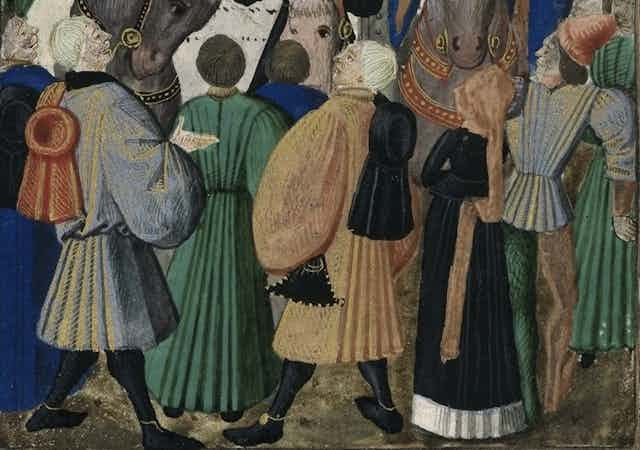Let me take you for a stroll down the high street of 12th-century Winchester – one of the great cities of medieval England – and introduce you to a few of the locals. Here’s Alberic Coquus, the cook, and over there is Ainulf Parcheminus, the parchment-maker. They are chatting to Luuing Scalarius (he builds ladders). Godric Softebred, who has his shop just down the road, is a baker – but his neighbours giggle behind his back and give his wife pitying glances.
You can’t miss Robert Crassus (“big, fat”), but I would hesitate to introduce you to Alfred Taddebelloc (“Toadbollock”) and you probably won’t want to stand too close to Radulf Scitliure (“shit-liver”, evidently cursed with chronic diarrhoea or some other stomach complaint). And perhaps we should simply cross the street to avoid me having to mention Godwin Clawecuncte (use your imagination) at all.
We know these names – with the intriguing clues they give about the people who carried them – from the two 12th-century surveys of Winchester property collectively known as the Winton Domesday. So, what’s in a medieval name? What can they tell historians about long-forgotten lives and individuals in the past? And why won’t you find anyone with the surname Toadbollock today?
These names don’t work in quite the same way as modern surnames. These (usually non-hereditary) medieval bynames add further detail to personal names, noting where someone was from, what job they did and even what they looked like or how they behaved.

Bynames often reflect physical attributes, such as those of Winchester’s Alestan Hwit (“white”), who probably had a fair complexion, or Alimer Longus (“tall”). You wouldn’t want to see Winchester’s Peter Agnell (“little lamb”) get into a fight with Godwin Bar (“boar”).
Many medieval historians have their own favourite names they’ve discovered during their research: Professor Anthony Bale of Birkbeck, University of London, mentions Tom Dustiberd (“dusty beard”) and the likely somewhat dishevelled Adam Charrecrowe (“scarecrow”), as well as Walter Boltuprith (“bolt-upright”).
Other bynames indicate trades and occupations. Richard Farrier was keeper of the king’s horses at Chester in the summer of 1283. Records show that he purchased cut grass for 20 horses, including that of the queen, and also for ten “great” horses arriving from Caernafon. He bought horseshoes, bridles, long ropes of hemp to make reins, as well as plenty of horse salve.
Other occupational bynames hint at less happy vocations. John Pynchware and his son worked as shoemakers in 15th-century Chester. But with a byname like that, how well did their shoes fit? Professor Matthew Davies of Birkbeck points to an apprentice tailor in London, 1486, named Rowland Lytillskyll. He doesn’t seem to have made it in his chosen career.
Rebel, rebel
Bynames can also tell us about ethnic identities. Several people in 12th-century Winchester were called “Iudeius” – members of what would become the city’s thriving medieval Jewish community. Godwin Francigena, with his English personal name and byname meaning “Frenchman”, reminds us what a cosmopolitan, multicultural European city this was.
But sometimes bynames point to political and social tensions. Dr Adam Chapman, at the Institute for Historical Research, shares the example of the 14th-century Welshman known as Madog Drwgwrthgymro: literally “bad to Welshmen”, but translated by the historian Robert Rees Davies more provocatively as “Saxon-lover” – a smear based on perceived disloyalty and ethnic betrayal.
Another Welshman, William Cragh, features in medieval records as an outlaw –- or freedom fighter, depending on your viewpoint – who rebelled against Norman rule and was hanged, but came back to life (that’s another story. He cuts less of a romantic, heroic figure when we translate his Welsh byname – perhaps “Scabby William” had suffered some kind of disfiguring disease as a child. Still, he was more likely known by his fellow Welshmen by the patronymic “ap Rhys” (“son of Rhys”).
Calling card
Somewhere in my own ancestry, someone probably worked as a clerk. Adam Chapman’s forebears possibly worked in a shop (“ceap-man” meant merchant, from the Old English “ceapan” meaning to sell or buy). Some bynames just stick around: Delia Smith doesn’t work in a forge, and Mary Beard doesn’t have one. But others, unsurprisingly, don’t outlast their original owners.
We see similar revisions when it comes to less appealing place names: just as William Cragh probably preferred being called William ap Rhys, the place where he was hanged in Swansea was renamed, in the late 19th century, from Gibbet Hill Road to the more estate agent-friendly North Hill Road.
So, why are medieval bynames so useful and engaging? For a start, some of them are hilarious – and they give us a humorous way into a seemingly remote and distant historical past. But, more than that, they offer a sense of connection with a real individual and a characteristic which defined them within their own, contemporary local community.
These medieval names also give us glimpses into something the big chronicles, charters and official history books often don’t tell us much about: ordinary people and their ordinary, colourful lives.

